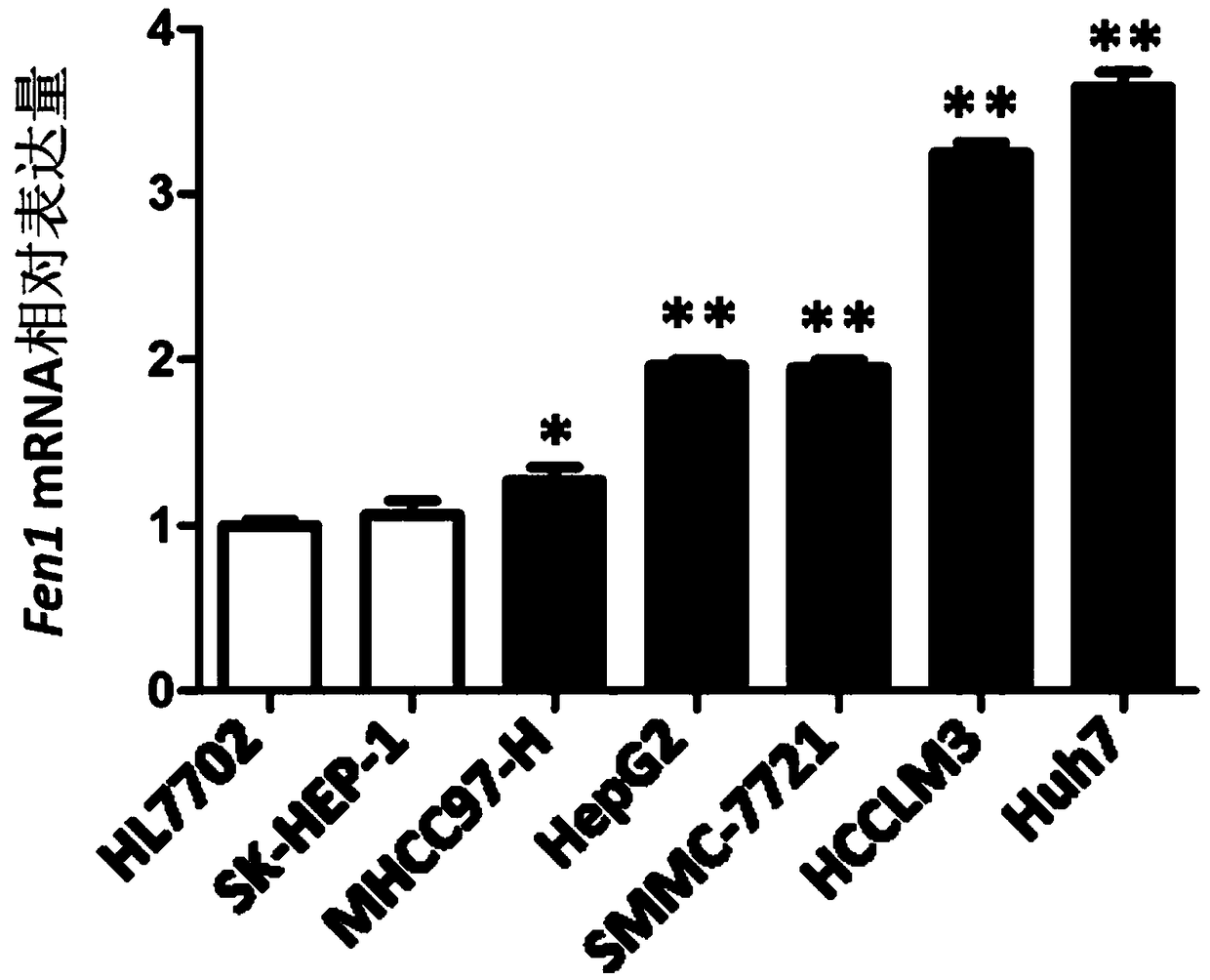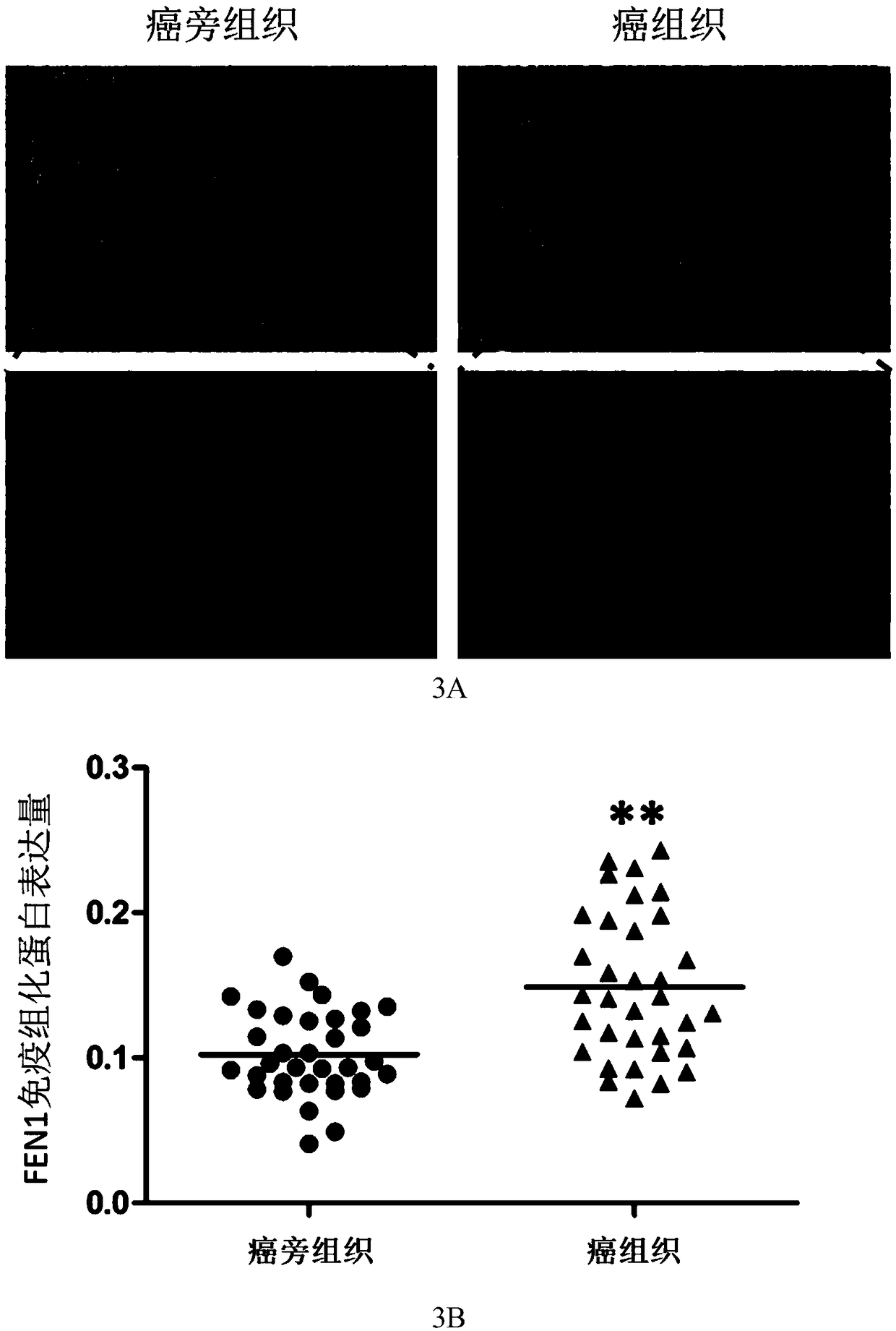Application of reagent for detecting expression level of FEN1 gene to preparation of reagents used for diagnosing and predicting invasion and metastasis of liver cancer
A technology of gene expression levels and reagents, applied in the biological field, to achieve the effect of promoting transfer
- Summary
- Abstract
- Description
- Claims
- Application Information
AI Technical Summary
Problems solved by technology
Method used
Image
Examples
Embodiment 1
[0064] Example 1 qPCR detection of the expression of FEN1 gene in liver cancer cells and normal liver cells
[0065] 1 sample collection:
[0066] Culture normal liver cell HL7702 and a series of liver cancer cells SK-HEP-1, MHCC97-H, HepG2, SMMC-7721, HCCLM3, Huh7. DMEM medium containing 10% fetal bovine serum and 1% double antibody in 37%, 5% CO 2 , Cultivated in an incubator with a relative humidity of 90%. Change the medium once every 2-3 days, and use 0.25% EDTA-containing trypsin for routine digestion.
[0067] 2 RNA sample preparation:
[0068] Cellular RNA was extracted using QIAGEN's cellular RNA extraction kit, and the operation was performed according to the specific steps in the manual.
[0069] 3 reverse transcription:
[0070] Use a 25μL reaction system, take 1ug total RNA from each sample as template RNA, and add the following components to the PCR tube: DEPC water, 5X reverse transcription buffer, 10mM dNTP, 0.1mM DTT, 30uM Oligo dT, 200U / μL M-MLV, templa...
Embodiment 2
[0080] Example 2 Using qPCR to detect the expression of FEN1 in patients with liver cancer and adjacent tumors
[0081] 1 The cancer tissues and corresponding paracancerous tissues of 16 pairs of liver cancer patients were collected, and the patients gave informed consent, and all the above specimens were obtained with the consent of the ethics committee.
[0082] 2 RNA sample preparation:
[0083] Tissue RNA was extracted using QIAGEN tissue RNA extraction kit, and the operation was performed according to the specific steps in the manual.
[0084] 3 reverse transcription:
[0085] Concrete steps are with embodiment 1.
[0086] 4 results:
[0087] The result is as figure 2 As shown in Fig. A, where the expression of FEN1 in 16 pairs of liver cancer patients and adjacent tumors was detected by qPCR, and Fig. B is the statistical result. Compared with adjacent tissues, the expression of FEN1 gene was up-regulated in liver cancer tissues, and the difference was statisticall...
Embodiment 3
[0088] Example 3 Using immunohistochemistry to detect the expression of FEN1 in the cancer and adjacent tumors of liver cancer patients
[0089] 1 Tissue block fixed, dehydrated, embedded
[0090] 16 pairs of liver cancer and paracancerous tissues were fixed in 4% paraformaldehyde for 3-4 hours, and tissues of appropriate size were put into embedding boxes for dehydration. Enter in order: 75% alcohol 1.5h, 95% alcohol 1.5h, 95% alcohol 1h, absolute ethanol 1.5h, absolute ethanol 1h, xylene No. 1 0.5h, xylene No. 2 0.5h. Turn on the embedding machine, use an iron lunch box to hold the paraffin block and put it into the tissue tank of the embedding machine to heat and dissolve. Put the dehydrated tissue together with the embedding box into the tissue tank of the machine in turn, and then put it into the paraffin lunch box No. 1 for the second wax dipping, and then paraffin lunch box No. 2 for three times of wax dipping. Then drop liquid paraffin into the mold, take out the soa...
PUM
 Login to View More
Login to View More Abstract
Description
Claims
Application Information
 Login to View More
Login to View More - R&D
- Intellectual Property
- Life Sciences
- Materials
- Tech Scout
- Unparalleled Data Quality
- Higher Quality Content
- 60% Fewer Hallucinations
Browse by: Latest US Patents, China's latest patents, Technical Efficacy Thesaurus, Application Domain, Technology Topic, Popular Technical Reports.
© 2025 PatSnap. All rights reserved.Legal|Privacy policy|Modern Slavery Act Transparency Statement|Sitemap|About US| Contact US: help@patsnap.com



